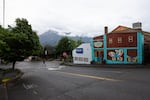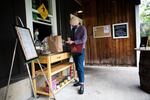On a Thursday evening at a brewery in Stevenson, Washington, Don Impson found a hint of normalcy. He ordered a beer and a burger. Then he glommed to a table in the beer garden.
For the Stevenson resident and everyone else the last two months, the simple act of sitting down at a restaurant has been as unreachable as one of the Columbia River Gorge’s steep switchbacks. He enjoyed the moment.
“Even if there are not people here — like there’s not today — it’s just a familiar place,” said Impson, a sawmill worker. “It’s good to be in a familiar place in a familiar setting.”
Last week, Skamania County became one of the first places in the western United States to reopen its restaurants and bars for sit-down dining. The county landed Gov. Inslee’s approval on May 11.
Plunked in former logging country about 40 miles east of Vancouver, the county is now a domain of hiking, camping, fishing and windsurfing. The community, like others in the Columbia River Gorge, has been anointed by out-of-towners as a “playground for Portland.”

A man walks through downtown Stevenson, Wash., Thursday, May 14, 2020. Skamania County was one of the first counties in Washington to partially reopen amid the COVID-19 pandemic.
Bradley W. Parks / OPB
That’s conflicting to restaurateurs and local officials who want tourists to return to the county, population 12,000, yet fear opening could set themselves up for an outbreak of the novel coronavirus.
Scott Anderson, mayor of Stevenson, described the county as an island. Neighboring counties remain closed, such as Yakima County to the northeast with more than 2,200 cases. Right across the river in Oregon, Hood River and Wasco counties have started reopening, as well.
And on Monday, a judge in Baker County, Oregon invalidated Gov. Kate Brown’s state of emergency.
“This is supposed to be a slow, gradual re-entry,” Anderson said. “Having an influx of out-of-town visitors does not help.”
At Walking Man Brewing Company, where Impson sat, only the beer garden offered seating. After a light rain, few besides him felt like taking a seat at the spaced-apart metal tables. Many took their take-out orders from a gloved hand through a window.
The brewery was among the first in the town of Stevenson to offer dine-in seating. Although the state allowed the brewery to offer seats indoors, co-owner Tabitha Wiggins said the brewery is keeping indoors off-limits at first.
“There’s definitely a lot to consider,” she said. “We’re taking a careful approach and kind of just trusting that if we’re able to follow the guidelines that are in place, that we’ll keep people safe and we’ll just kind of adjust and move from there.”

Don Impson enjoys a beer at Walking Man Brewing Company in Stevenson, Wash., Thursday, May 14, 2020. Walking Man opened its beer garden to customers as Skamania County entered the first phase of reopening amid the COVID-19 pandemic.
Bradley W. Parks / OPB
As warm weather marches in, local officials worry the careful approach may not be enough.
In late March, as governors in Oregon and Washington both encouraged — but did not order — residents to stay home, the trails brimmed with hikers.
That image is crystalized to the Skamania County’s Board of Commissioners, as they placed more portable toilets in early May bracing for visitors being unable to use businesses' bathrooms. And they've discussed with the U.S. Forest Service keeping marquee trails like Dog Mountain and Beacon Rock closed.
“We’re concerned with having a high volume of people coming out to our area and overwhelming any of our public safety agencies,” said Commissioner Bob Hamlin. “But, we at the same time are a very tourist-dependent economy. We’re hopefully not going to get inundated.”
The crowds came during a particularly sunny Mother’s Day weekend. Backwoods Brewing, a popular pit stop for people heading home after a day of hiking, made almost as much revenue as it would during a normal year.
Co-owner Steve Waters welcomed the business, partly because smaller businesses are more vulnerable when missing prime sales season. The brewery, in the unincorporated town of Carson, is also making money while its second location in Portland’s Pearl District struggles.
“We’re about to get hit by our busiest season, and we are — Portland and Vancouver and all these metro areas out here — we’re their playground,” Waters said. “Sometimes it upsets people in the gorge, but as a business owner on the gorge, I’m like, ‘No. Yes, that’s awesome. Please come play out here.”
But the brewery isn’t rushing to open its doors either. Waters said they are prioritizing safety. He also lamented losing a “fun, free-for-all” vibe that opening with social distancing guidelines inhibits.
“We don’t like saying no to people. We don’t like telling them where they can and can’t go,” Waters said.
Just three Skamania County residents have tested positive for COVID-19, one of whom was hospitalized. The nearest hospital is in neighboring Klickitat County, and there is only one medical clinic. Just 251 people have been tested there to date.

A woman named Hilary signs for her food to-go at Walking Man Brewing Company in Stevenson, Wash., Thursday, May 14, 2020. Skamania County was one of the first counties in Washington to partially reopen amid the COVID-19 pandemic.
Bradley W. Parks / OPB
Skamania County’s position is manageable, said Steven Krager, the county’s deputy health officer. He approved the plans to reopen. He said as long as restaurants and patrons abide by the state’s guidelines, transmissions shouldn’t pick up.
But that hypothesis, he said, counts on would-be tourists mostly staying home.
“We still don’t want people traveling large distances and coming from different areas if possible,” he said. “I understand that’s probably still going to happen.”
Krager added the virus transmits much more poorly outdoors. He said opening trails may give people more real estate to spread out, as long as the trails don’t funnel people together.
Local officials saw what happened in Kittitas County two weeks ago. It was poised to reopen like Skamania, with 15 total cases during the pandemic. Right after it applied to reopen, an outbreak emerged at a food processing plant that drove the case count to 96.
That makes reopening a “double-edged sword,” said Anderson, Stevenson’s mayor.
Stevenson is the biggest town in Skamania County and relies on tourists almost as much as restaurants. Taxes from overnight stays and retail sales, which peak from June to September, make up 40% of its general fund.
In fact, the city’s biggest employer is Skamania Lodge. The alpine-esque resort has remained shuttered since early March. And scrapped are some of the town’s biggest annual events: windsurfing and canoeing competitions, as well as festivals for bluegrass and blues musicians.
“That’s a huge hit for the city,” Anderson said. “We’re constantly looking at the numbers. What does this mean for us? For now, and for next year?”
But Anderson urged visitors to stay home for now.
“We can’t wait to get everyone back out here, but not now. Give us a couple weeks to get our feet wet,” he said. “Then help us get our economy turned around.”
Impson, the sawmill worker eating his burger in the beer garden, said he doesn’t feel that way, but he understands his neighbors who do.
“I’m not worried about tourists, but I respect other people that are worried about it. So, out of respect for them. Because it does make people anxious,” he said.